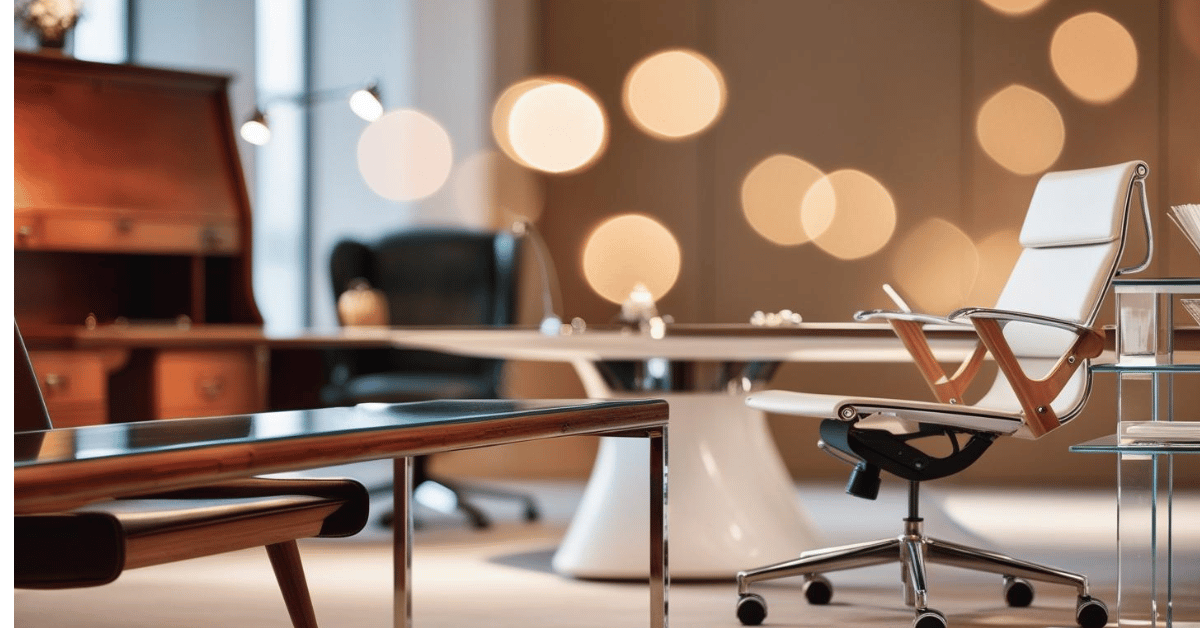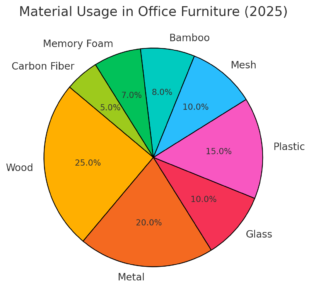Table of Contents
ToggleThe evolution of materials in office furniture has been driven by advancements in materials, design trends, and workplace ergonomics. From classic wooden desks to modern ergonomic solutions, office furniture materials have played a crucial role in enhancing workplace efficiency, durability, and sustainability.
With the increasing demand for office furniture in Dubai, businesses are shifting towards eco-friendly materials, ergonomic designs, and innovative workspace solutions. Whether it’s traditional wood, durable metal, breathable mesh, or smart adaptive materials, each evolution in office furniture aims to improve productivity and comfort.
As a leading provider of premium office furniture in Dubai, Cosmo Furniture Store offers cutting-edge solutions tailored to modern office needs. By integrating sustainable materials and advanced technology, Cosmo Furniture Store continues to shape the future of office workspaces, ensuring both functionality and style.
1. Traditional Materials: The Foundations of Office Furniture
The earliest forms of office furniture were built to provide durability, functionality, and a professional aesthetic. Before the introduction of modern materials and ergonomic designs, traditional office furniture relied on wood, metal, and glass, each offering unique benefits and challenges.
Wood: The Timeless Classic
Wood has been a cornerstone of office furniture for centuries, providing both functionality and aesthetic appeal. Hardwoods such as mahogany, oak, and walnut were highly sought after due to their durability, strength, and rich appearance. Wooden desks, chairs, and cabinets often symbolized prestige and sophistication, making them a preferred choice for executive offices.
However, despite its elegance, traditional wooden furniture had some drawbacks:
- Bulky and Heavy – Solid wood furniture was often large and difficult to move.
- Limited Flexibility – Wooden designs were rigid and lacked adjustability.
- High Maintenance – Wood required regular polishing and protection against moisture, termites, and warping.
Today, while solid wood remains a luxury choice, modern office furniture incorporates engineered wood and sustainable alternatives to enhance durability and reduce environmental impact.
Metal: Industrial Strength
With the rise of industrialization in the late 19th and early 20th centuries, metal became a widely used material in office furniture. Steel and aluminum revolutionized furniture manufacturing by offering:
- High durability – Metal furniture could withstand wear and tear better than wood.
- Fire and Pest Resistance – Unlike wood, metal was non-combustible and resistant to termites.
- Sleek and Professional Appearance – Ideal for modern, minimalist office spaces.
Metal became the primary material for filing cabinets, storage units, and office partitions, helping businesses organize documents efficiently. However, early metal furniture had its challenges:
- Cold and Uncomfortable – Metal surfaces were not ergonomic or comfortable for prolonged use.
- Heavy and Prone to Rust – While durable, older metal designs were cumbersome and required anti-rust coatings.
Today, modern metal office furniture is lighter, corrosion-resistant, and often combined with other materials like wood and mesh for ergonomic benefits.
Glass: A Touch of Sophistication
As workplaces evolved, glass furniture emerged as a symbol of modernity and transparency. Glass-topped desks and meeting tables became popular in corporate settings due to their sleek and elegant appearance.
Key Benefits of Glass Office Furniture:
✔ Aesthetic Appeal – Enhances office interiors with a clean and professional look.
✔ Light Reflection – Creates an open and airy office environment.
✔ Easy Maintenance – Glass surfaces are easy to clean and resistant to stains.
However, glass furniture also presented some limitations:
✖ Fragility – Despite being treated for strength, glass remained susceptible to cracks and scratches.
✖ Fingerprint and Dust Marks – Required frequent cleaning to maintain a polished look.
✖ Lack of Privacy – Glass partitions and desks did not offer soundproofing or storage benefits.
To address these concerns, modern office furniture now incorporates tempered and frosted glass with reinforced coatings, making it more durable and functional.
2. The Transition to Modern Materials
Plastic and Laminates: Cost-Effective and Versatile
In the mid-20th century, plastic and laminate materials transformed office furniture design. Their lightweight, durable, and cost-effective nature made them widely popular for desks, partitions, and modular office setups.
Foam and Fabric: Comfort and Ergonomics
The emphasis on employee comfort led to the integration of foam padding and fabric upholstery in office chairs. These materials helped improve posture and reduce workplace fatigue, paving the way for ergonomic furniture solutions.
Synthetic Materials: Durability and Flexibility
The late 20th century saw the emergence of synthetic materials like polyurethane, acrylic, and polypropylene. These materials offered flexibility, ease of maintenance, and modern aesthetic appeal, making them ideal for contemporary office environments.
3. The Rise of Sustainable and High-Tech Materials
Recycled and Eco-Friendly Materials
With growing environmental concerns, companies are now opting for eco-friendly office furniture. Cosmo Furniture Store provides sustainable solutions using bamboo, reclaimed wood, and recycled plastics, ensuring that businesses in Dubai can create environmentally responsible workspaces.
Mesh and Memory Foam: Advanced Comfort
Modern ergonomic office chairs now feature breathable mesh backrests and memory foam seats for superior comfort. These materials enhance airflow and provide lumbar support, reducing strain for employees working long hours.
Smart and Adaptive Materials
The latest innovations in office furniture in Dubai include the use of smart textiles, carbon fiber, and self-healing surfaces. These advanced materials enhance user experience with temperature regulation, adaptive support, and extended furniture lifespan.
4. Overview of Material Preferences in Modern Offices
| Material | Advantages | Common Applications |
|---|---|---|
| Wood | Elegant, durable, customizable | Desks, storage units, conference tables |
| Metal | Sturdy, fire-resistant, long-lasting | Filing cabinets, frames, partitions |
| Glass | Aesthetic appeal, easy to clean | Desktops, partitions, meeting tables |
| Plastic | Lightweight, affordable, versatile | Chairs, modular desks, accessories |
| Mesh | Breathable, ergonomic support | Office chairs, partitions |
| Bamboo | Eco-friendly, stylish | Desks, chairs, cabinets |
| Memory Foam | Comfort, posture support | Ergonomic chairs, seat cushions |
| Carbon Fiber | Lightweight, durable | High-end office furniture |
5. Future Trends in Office Furniture Materials
As workplaces evolve, the materials used in office furniture in Dubai are also undergoing significant transformations. With a strong emphasis on sustainability, innovation, and adaptability, future office furniture will incorporate biodegradable materials, smart technologies, and 3D printing advancements. Below are some key trends that are shaping the future of office furniture materials.
1. Biodegradable and Sustainable Solutions
With growing environmental concerns, businesses are prioritizing sustainable office furniture that minimizes ecological impact. Companies in Dubai are increasingly opting for:
- Bamboo and Recycled Wood – These materials are renewable, durable, and provide a natural aesthetic. Bamboo, in particular, is fast-growing and highly sustainable, making it a top choice for modern office designs.
- Upcycled Plastics and Metals – Recycled materials reduce waste and offer the same level of durability as conventional materials. Many office chairs, desks, and partitions are now made from upcycled plastic and repurposed metal.
- Eco-Friendly Upholstery – Sustainable fabrics, such as organic cotton, wool, and plant-based leather, are replacing synthetic upholstery. These materials are biodegradable, reducing landfill waste.
- Non-Toxic and Low-VOC Finishes – Paints, adhesives, and coatings with low volatile organic compounds (VOCs) are being used to improve indoor air quality, promoting a healthier work environment.
Sustainable office furniture not only benefits the environment but also enhances employee well-being by providing healthier, toxin-free workspaces.
2. 3D-Printed Furniture: Customization with Minimal Waste
The rise of 3D printing technology is revolutionizing the way office furniture is manufactured. This cutting-edge approach offers:
- Precision and Material Efficiency – 3D printing uses exact material quantities, reducing waste and optimizing resource utilization.
- Custom Designs – Businesses can create tailored furniture solutions based on workspace needs. From ergonomic chairs to modular desks, 3D printing allows for unique, space-saving designs.
- Lightweight and Durable Structures – 3D-printed furniture can incorporate honeycomb structures that maintain durability while significantly reducing weight.
- Sustainability – Many biodegradable filaments, such as PLA (polylactic acid) derived from cornstarch or sugarcane, are being used to create eco-friendly office furniture.
With 3D printing, companies in Dubai can embrace sustainable, cost-effective, and highly personalized office furniture solutions.
3. Smart Materials Integration: The Future of Adaptive Workspaces
The next generation of office furniture in Dubai is set to incorporate smart materials that adapt to users’ needs in real time. Innovations in this field include:
- Temperature-Sensitive Surfaces – Some office desks and chairs are being designed with thermo-responsive materials that adjust to body heat, providing an optimal seating experience.
- AI-Driven Ergonomic Designs – Office chairs with built-in AI sensors can track posture and automatically adjust lumbar support, seat height, and tilt to maintain proper ergonomics.
- Self-Healing Materials – Advanced coatings and polymers are now capable of repairing minor scratches and dents, extending the lifespan of office furniture.
- Sound-Absorbing Panels and Desks – Smart acoustic materials help reduce workplace noise, creating a more productive and distraction-free environment.
- Augmented Reality (AR) and Smart Desks – Some office furniture is now integrating AR interfaces and IoT-enabled workstations, allowing employees to customize desk height, lighting, and temperature with voice commands or mobile apps.
These advancements ensure that office furniture is not just functional but also interactive and user-friendly, significantly improving the modern work experience.
Related Links
- Why Do You Need Office Furniture?
- Top Trends in Dubai’s Interior Design
- Popular Affordable Luxury Trends in Dubai
- Budget-Friendly & Luxury Interior Design Solutions in Dubai
- Smart Hybrid Work Furniture for Modern Offices in Dubai
Material Usage in Office Furniture (2025)
Conclusion
The transformation of office furniture materials reflects the ever-evolving needs of modern workplaces, prioritizing durability, aesthetics, sustainability, and comfort. From traditional wood and metal to smart, eco-friendly, and adaptive materials, office furniture continues to evolve, enhancing both functionality and employee well-being.
For businesses looking to upgrade their office spaces with high-quality office furniture in Dubai, Cosmo Furniture Store offers premium solutions tailored to modern workspace requirements. With a strong commitment to innovation, ergonomic design, and sustainability, Cosmo Furniture Store leads the way in providing stylish, durable, and environmentally friendly office furniture that meets the demands of contemporary work environments.
FAQs
1. What are the most commonly used materials in office furniture?
The most commonly used materials in office furniture include wood, metal, glass, plastic, mesh, bamboo, memory foam, and carbon fiber. These materials vary in durability, aesthetics, and sustainability, depending on workplace needs.
2. Why is sustainability important in modern office furniture?
Sustainability ensures that office furniture is made using eco-friendly materials such as recycled wood, bamboo, and upcycled plastic. This reduces environmental impact, promotes responsible sourcing, and aligns with corporate sustainability goals.
3. How have technological advancements influenced office furniture materials?
Technology has introduced smart materials, 3D-printed furniture, and AI-integrated ergonomic designs. These innovations enhance comfort, durability, and adaptability to modern office setups, improving overall workplace efficiency.
4. What are the benefits of using mesh and memory foam in office chairs?
Mesh materials provide breathability, reducing heat buildup during long working hours, while memory foam offers posture support, preventing back pain and discomfort, making them ideal for ergonomic office chairs.
5. What are the future trends in office furniture materials?
The future of office furniture materials includes biodegradable materials, carbon fiber desks, AI-integrated ergonomic chairs, and self-healing surfaces. These innovations aim to improve workplace comfort, aesthetics, and sustainability.


